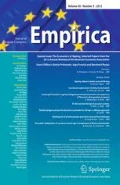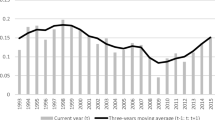Abstract
We use parametric duration analysis to study the survival of Austrian firms. We find that hazard rates in both manufacturing and services initially increase, reach a peak after the first year of operation and then decrease with age. The maximum hazard rate is higher in services. We also find differences in hazard rates among different types of manufacturing industries distinguished by the nature of their sunk costs, their reliance on human resources and inputs from external services. Finally, we find that larger initial size and higher market growth, and at the same time lower net entry and declining market concentration prolong the life of an entrant.


Similar content being viewed by others
Notes
Surveys of the literature on the mobility of firms, of which the literature on firm survival is a permanent strand, include Siegfried and Evans (1994), Geroski (1995), Sutton (1997) and Caves (1998). Of related interest is the sociological literature on organizational ecology exemplified by Hannan and Carroll (1992) and Carroll and Hannan (2000).
In the framework of empirical duration analysis, the positive effect of an explanatory variable on duration derives from its negative effect on the probability of exit. We will return to this point in Sect. 3.2.
We exclude these for various reasons. Competition in the farming industry is largely shaped by its unique regulatory environment. Data on mining and utilities are sparse, while non-market services mostly belong to the public sector.
Stiglbauer (2003) argues that, due to the economies of scale in administrative reporting, the bulk of the data can be found on the level of enterprises, not establishments. Clearly, this uncertainty is negligible for small firms.
At the same time, net entry can proxy opportunities perceived by entrants (Peneder 2007).
This hypothesis takes a bird's eye view of the evolution of industries by identifying several stages of development, starting with an embryonic industry environment, to a growing industry followed by eventual shakeout (a mass exit), maturity and decline (Klepper 1996).
For a discussion of censoring and truncation in parametric models see, for example, chapter 4 in Cleves et al. (2004).
The degrees of freedom are as follows: 9 for the generalized gamma model, 8 for the log-normal and Weibull models, and 7 for the model based on exponential distribution.
References
Agarwal R, Audretsch DB (2001) Does start-up size matter? The impact of technology and product life cycle on firm survival. J Ind Econ 49:21–44
Agarwal R, Sarkar MB, Echambadi R (2002) The conditioning effect of time on firm survival: a life cycle approach. Acad Manage J 45:971–994
Amir R, Lambson V (2003) Entry, exit, and imperfect competition in the long run. J Econ Theory 110:191–203
Audretsch DB (1991) New firm survival and the technological regime. Rev Econ Stat 68:441–450
Audretsch DB, Mahmood T (1995) New firm survival: new results using a hazard function. Rev Econ Stat 77:97–103
Baldwin JR, Gorecki PK (1991) Firm entry and exit in Canadian manufacturing sector, 1970–1982. Can J Econ 24:300–323
Cabral LMB, Mata J (2003) On the evolution of the firm size distribution: facts and theory. Am Econ Rev 93:1075–1090
Carroll GR, Hannan MT (2000) The demography of corporations and industries. Princeton University Press
Caves RE (1998) Industrial organization and new findings on the turnover and mobility of firms. J Econ Lit 36:1947–1982
Cefis E, Marsili O (2005) A matter of life and death: innovation and firm survival. Ind Corpor Change 14:1–26
Cleves MA, Gould WW, Gutierrez RG (2004) An introduction to survival analysis using STATA®, Stata Press
Cox DR, Oakes D (1984) Analysis of survival data, Chapman & Hall
Desai M, Gompers P, Lerner J (2003) Institutions, capital constraints and entrepreneurial firm dynamics: evidence from Europe. NBER Working Papers 10165, National Bureau of Economic Research
Dixit A (1989) Entry and exit decisions under uncertainty. J Polit Econ 97:620–638
Dunne T, Roberts MJ, Samuelson L (1988) Patterns of firm entry and exit in US manufacturing industries. RAND J Econ 19:495–515
Ericson R, Pakes A (1995) Markov-perfect industry dynamics: a framework for empirical work. Rev Econ Stud 62:53–82
Evans D (1987) Tests of alternative theories of firm growth. J Polit Econ 95:657–674
Freeman J, Carroll GR, Hannan MT (1983) The liability of newness. age dependence and organizational death rates. Am Sociol Rev 48:692–710
Hannan MT, Carroll GR (1992) Dynamics of organizational populations: density, legitimation, and competition. Oxford University Press
Geroski PA (1995) What do we know about entry? Int J Indust Organ 13:421–440
Hölzl W (2005) Tangible and intangible sunk costs and the entry of firms in a small open economy: the case of Austria. Appl Econ 37:2429–2443
Jovanovic B (1982) Selection and the evolution of industry. Econometrica 50:649–670
Kalbfleisch JD, Prentice RL (1980) The statistical analysis of failure time data. John Wiley & Sons
Kaniovski S, Peneder M (2002) On the structural dimension of competitive strategy. Ind Corpor Change 113:557–579
Klepper S (1996) Entry, exit, growth, and innovation over the product life cycle. Am Econ Rev 86:562–583
Lancaster T, The econometric analysis of transition data, 1990, Econometric Society Monographs No. 17
Le CT (1997) Applied survival analysis. John Wiley & Sons
Mata J, Portugal P (1994) Life duration of new firms. J Indust Econ 42:227–245
Mata J, Portugal P, Guimaraes P (1995) The survival of new plants: start-up conditions and post-entry evolution. Int J Indust Organ 13:459–481
Peneder M (2001) Entrepreneurial competition and industrial location. Edward Elgar, Cheltenham, UK
Peneder M (2005) Creating industry classifications by statistical cluster analysis. Estudios de Economica Aplicada 23:451–463
Peneder M (2007) Firm entry and turnover: the nexus with profitability and growth. Small Bus Econ (forthcoming)
Siegfried JJ, Evans LB (1994) Empirical studies of entry and exit: a survey of the evidence. Rev Indust Organ 9:121–155
Stieglbauer A, Job and worker flows in Austria 1978–1998, Ph.D. thesis, University of Linz
Sutton J (1991) Sunk costs and market structure. MIT Press, Cambridge, MA
Sutton J (1997) Gibrat’s legacy. J Econ Lit 35:40–59
Sutton J (1998) Technology and market structure. MIT Press, Cambridge, MA
Wagner J (1994) The post-entry performance of new small firms in German manufacturing industries. J Indust Econ 42:141–154
Acknowledgments
This paper benefited from comments and suggestions by Werner Hölzl, Peter Huber, Michael Pfaffermayr and Egon Smeral, and the editorial assistance of Christine Kaufmann and Astrid Nolte. We are particularly indebted to Marianne Schöberl and Peter Huber, who invested much time, effort and ingenuity in compiling the micro-data from the Austrian social security files and shared them with us. All remaining errors are the sole responsibility of the authors. Both authors gratefully acknowledge financial support from the Jubiläumsfond of the Austrian National Bank (Grant No. 11092).
Author information
Authors and Affiliations
Corresponding author
Rights and permissions
About this article
Cite this article
Kaniovski, S., Peneder, M. Determinants of firm survival: a duration analysis using the generalized gamma distribution. Empirica 35, 41–58 (2008). https://doi.org/10.1007/s10663-007-9050-3
Published:
Issue Date:
DOI: https://doi.org/10.1007/s10663-007-9050-3




